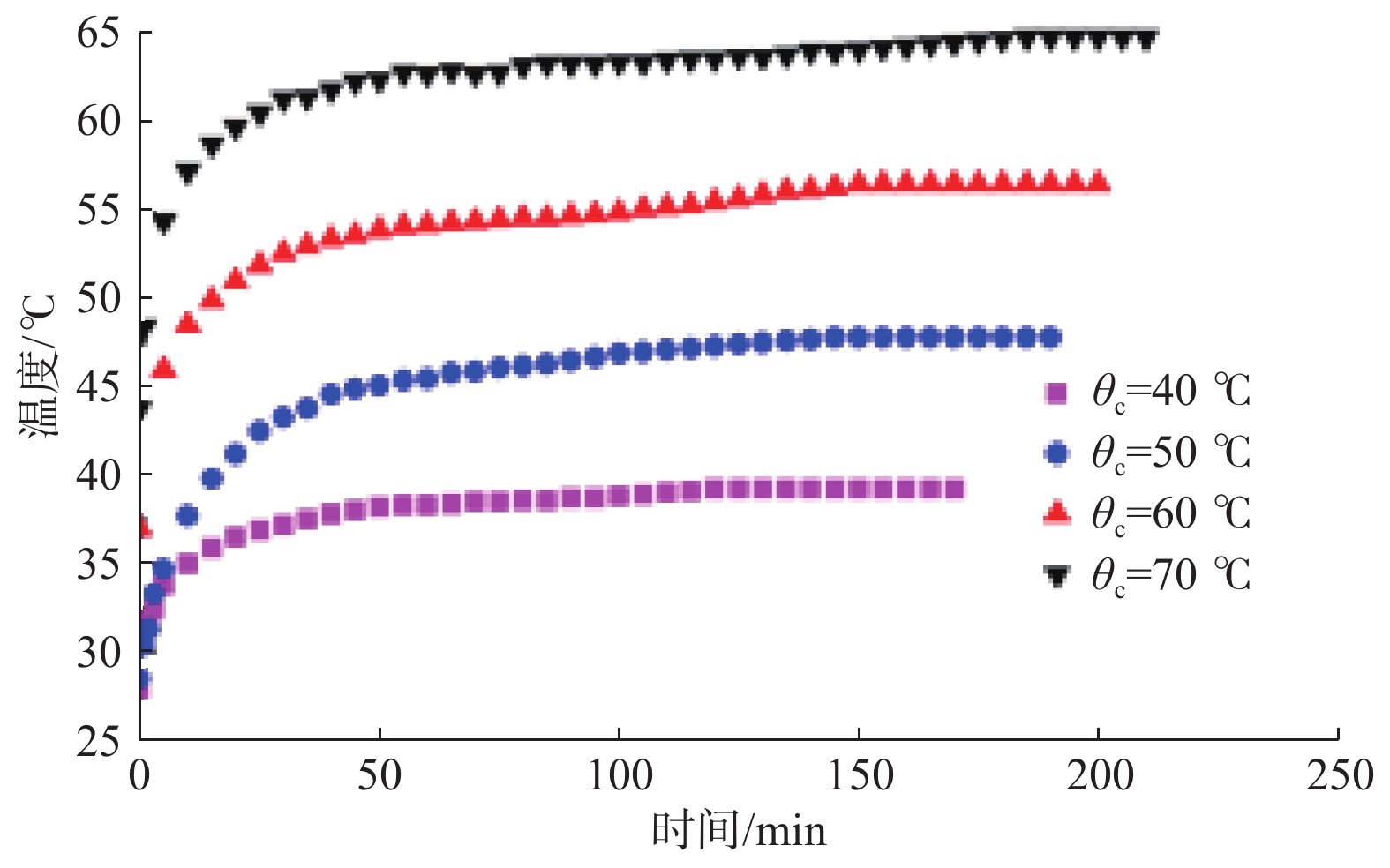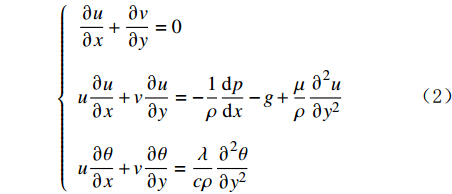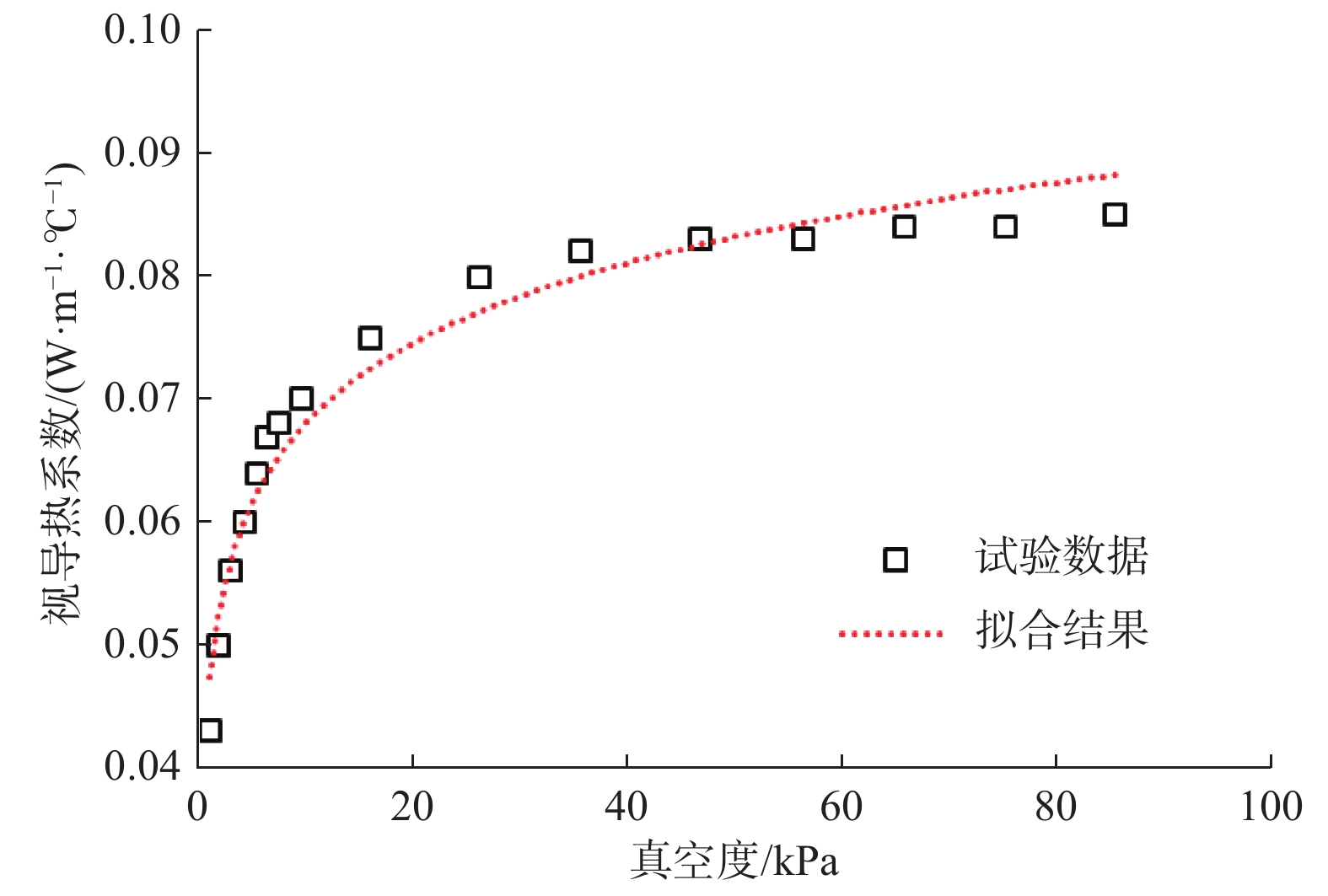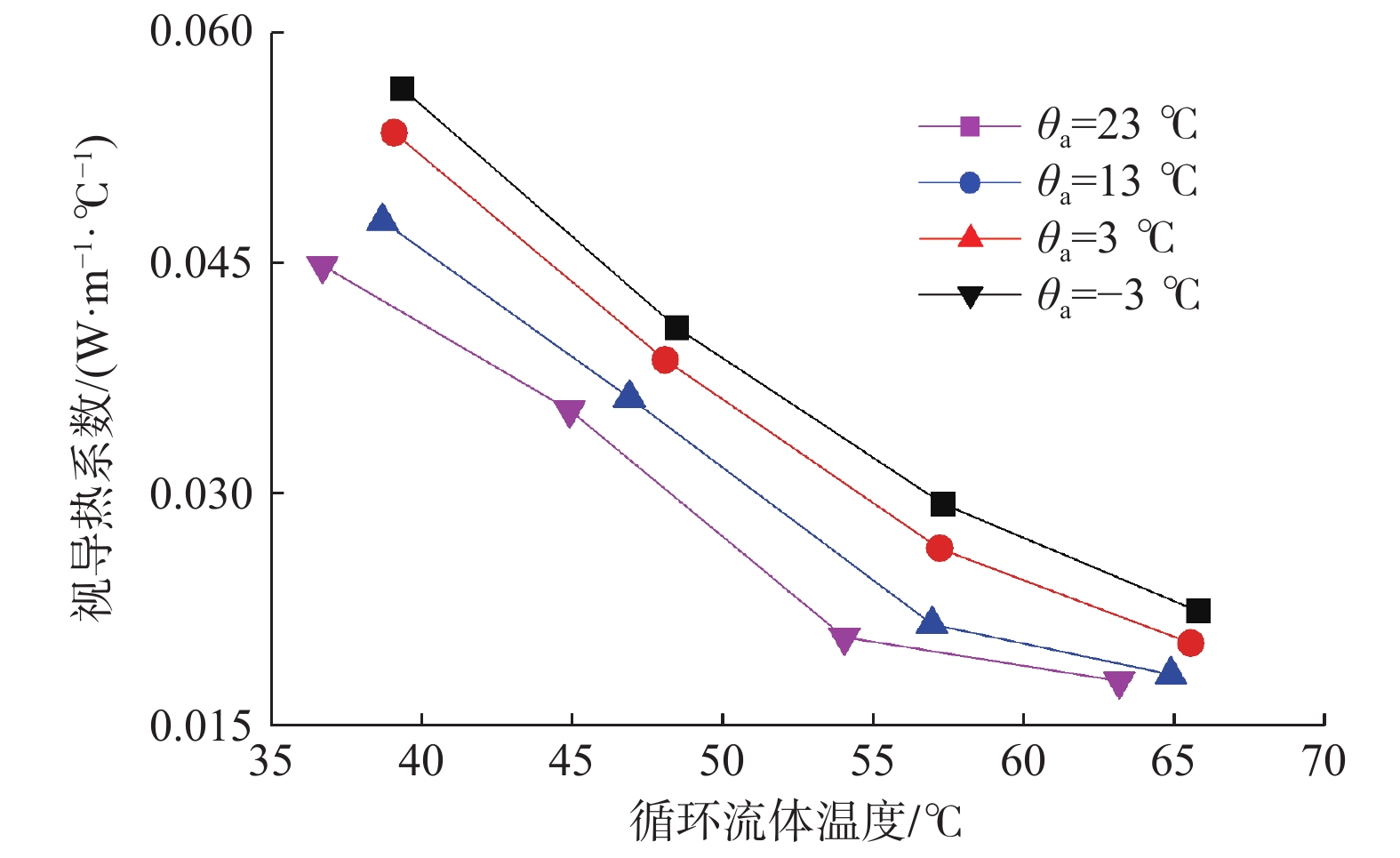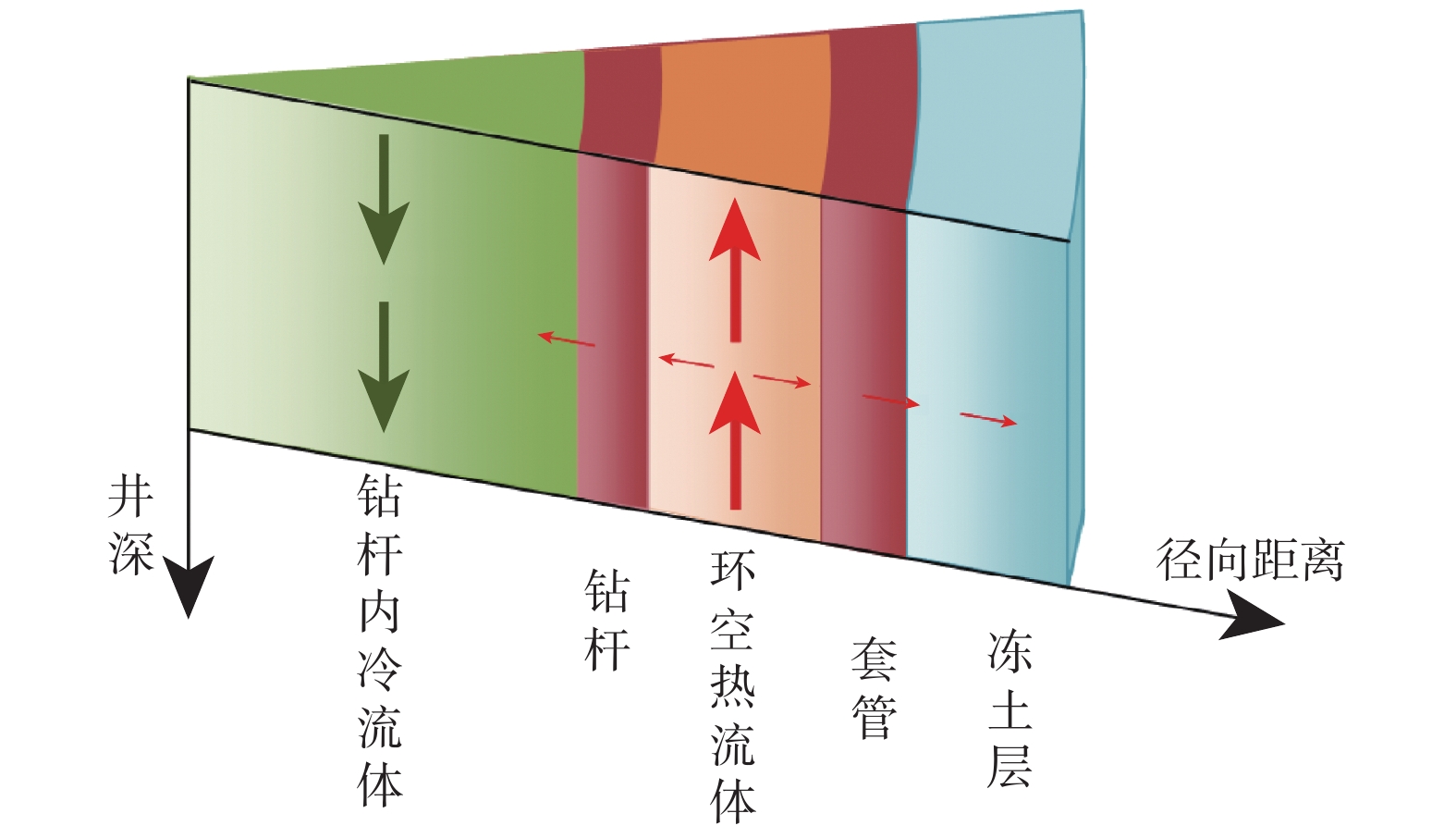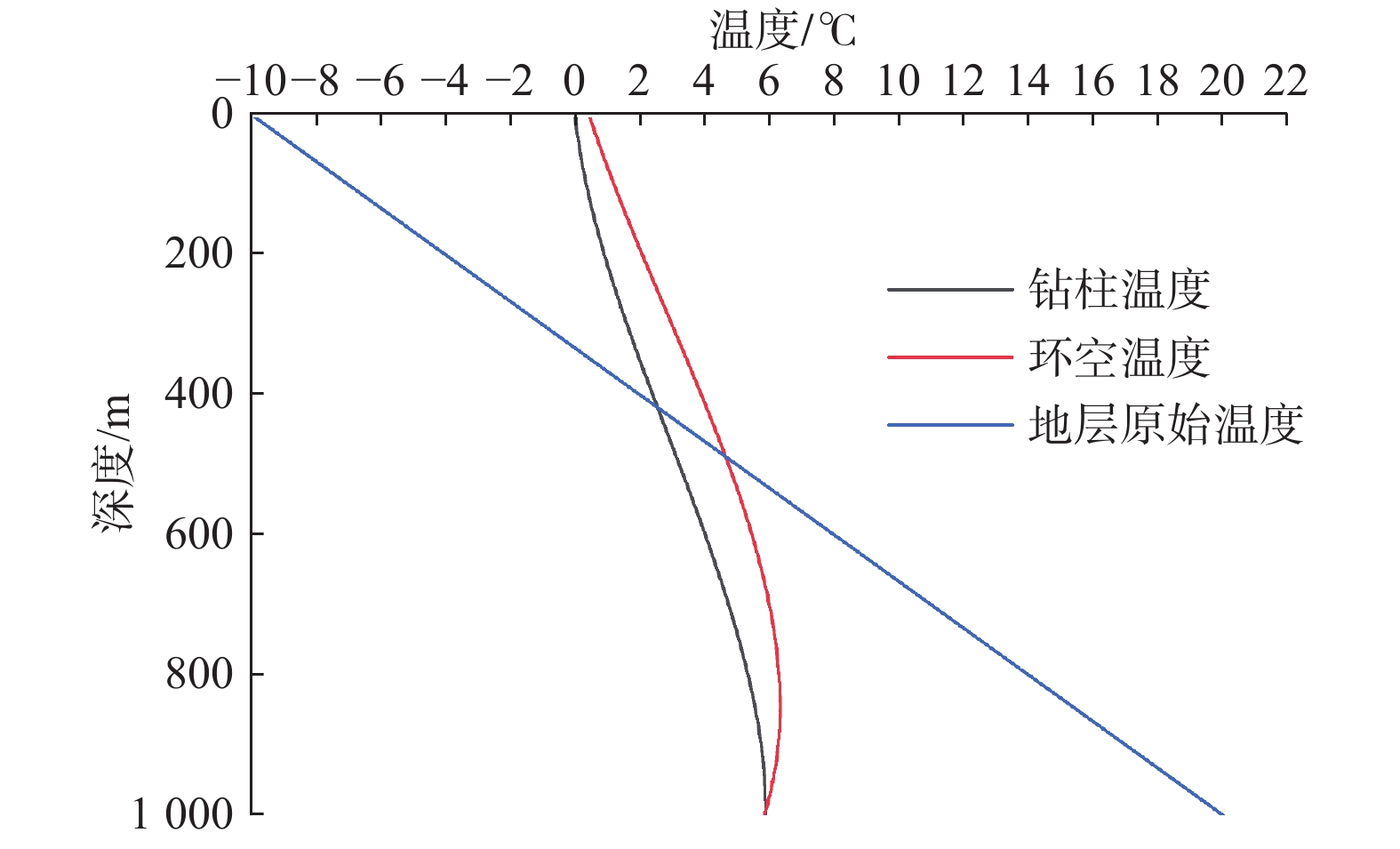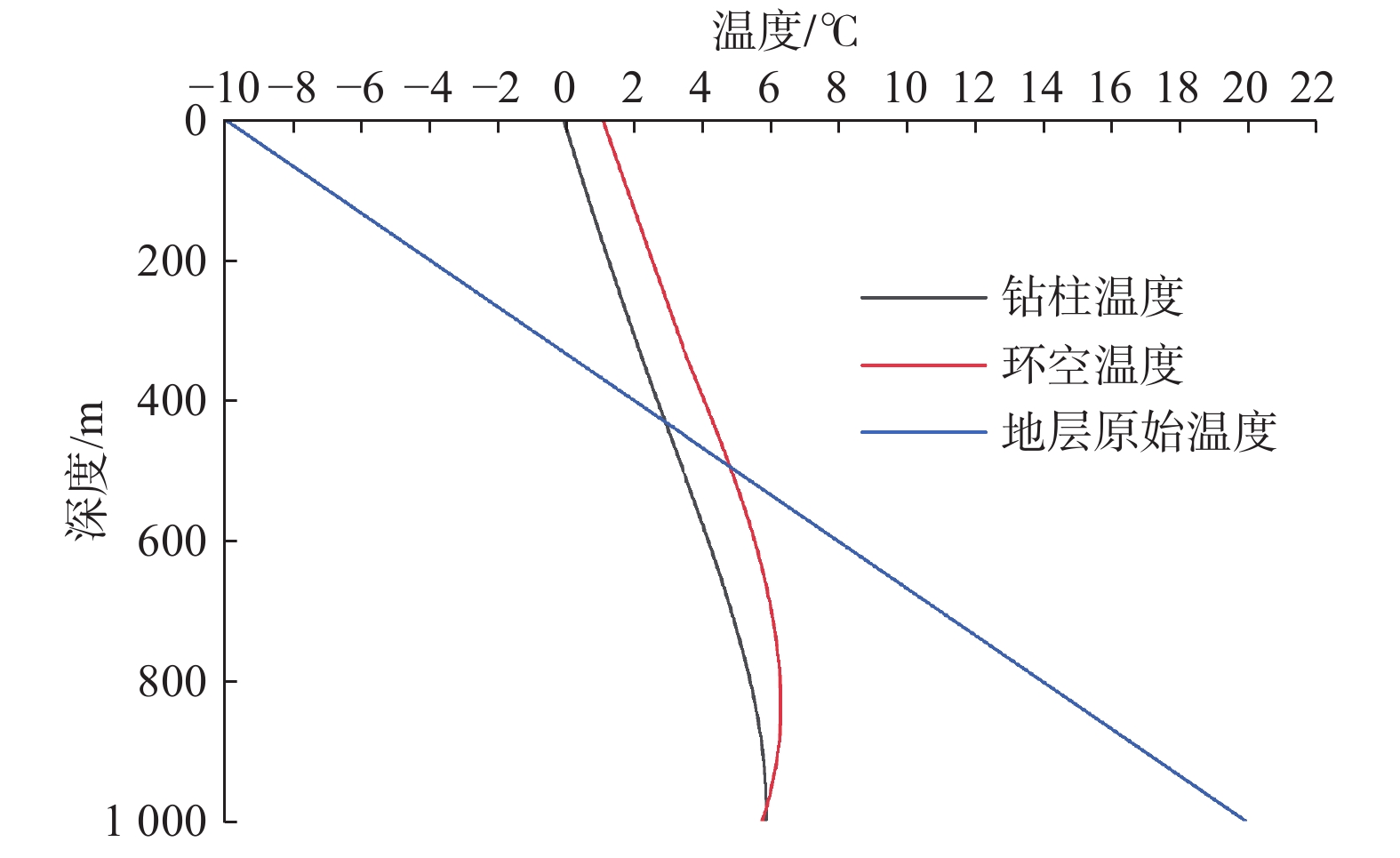Performance Test and Numerical Simulation Research on Vacuum Insulated Casings for Permafrost Protection
-
摘要: 针对冻土层钻井过程中可能引发的冻土融沉和井口下沉等问题,研究采用真空隔热套管保护冻土层,并采用试验和数值模拟方法研究了真空隔热套管的保温性能。试验结果显示:真空隔热套管能在限制径向传热的同时限制表面的轴向传热,减小套管表面的升温幅度和升温范围;其视导热系数远小于传统套管,在不同环境温度和钻井液温度下都具有保温性能;降低真空度可以提高其保温性能,强化其对冻土层的保护。数值模拟结果表明,真空隔热套管可以减小冻土层融化区域,降低冻土融沉和井口下沉的可能性。在此基础上,提出了降低真空度、加大套管总成内的隔热套管段长度和接箍处包裹隔热泡沫等提高真空隔热套管保温性能的工程措施。研究结果验证了真空隔热套管对冻土层保护的有效性和稳定性,对开发极地油气资源具有一定的指导作用。Abstract: Because permafrost settles as it thaws, there is a risk that the wellhead will sink while drilling, and therefore, vacuum insulated casings were introduced to protect the permafrost, and their thermal insulation performance was analyzed through experiments and numerical simulations. The field test results showed that the vacuum insulated casings could limit both the radial and the axial heat transfer on the surface simultaneously, which restricts the range and magnitude of temperature increase on the casing surface. Because the vacuum insulated casings have much lower apparent thermal conductivity than that of traditional casings, their thermal insulation performance can be maintained at various ambient temperatures and drilling fluid temperatures. In addition, decreasing the vacuum degree can improve their thermal insulation performance and strengthen their protection of the permafrost. The numerical simulation results indicated that the vacuum insulated casings could greatly reduce the permafrost thaw zone and lower the possibility of settling and wellhead sinking due to permafrost thaw. Furthermore, the following measures were adopted to enhance the thermal insulation performance of the vacuum insulated casings, including vacuum degree reduction, insulated casings length increase in the casing assembly, and insulation foam wrapping at the coupling. The research results have verified the effectiveness and stability of vacuum insulated casings in protecting the permafrost, so as to guide the development of oil and gas resources in the Arctic region.
-
北极地区油气资源丰富,开发前景非常广阔,有望成为全球能源接替潜力区[1-6]。极地的油气资源大都分布在多年冻土区,温度区间为–50~–5 ℃。在极地深部地层钻井过程中,上返的钻井液经过冻土地层时融化其中的冰颗粒,会导致冻土融沉和井口下沉。因此,冻土地层保温是安全开采极地油气资源的关键问题之一。目前,主要采用控制钻井液注入温度的方法[7-11]控制钻井过程中的井筒温度,但该方法要求使用低温钻井液钻进冻土层,这样既会破坏环境,又会增加钻井成本。使用隔热套管封隔冻土层可以提供长期、环保和经济的保温效果,避免次生危害。隔热套管的隔热保温性能在注热开采中得到了验证[12-13],但目前还很少有人研究真空隔热套管对冻土地层的保护。
针对钻进冻土中保障井筒完整性和安全性的需求,笔者对一种真空隔热套管的保温性能进行了试验,分析了其外壁温度的时间演化和空间分布,然后构建数学模型,量化其视导热系数,进行敏感性分析,评价了真空隔热套管在各类环境中保温性能的稳定性。在此基础上,结合数值模拟方法研究了其实际工程效用,提出了提高真空隔热套管保护冻土层效果的工程措施。
1. 真空隔热套管保温性能试验
1.1 试验目的和方法
为了量化真空隔热套管对冻土层的保护性能,设计了真空隔热套管保温性能测试系统(见图1)。该系统将循环流体控温装置和套管连接起来,放置在恒温库中。试验真空隔热套管外径177.8 mm,长210 cm,导热系数43.75 W/(m·℃),初始真空度50 Pa;接箍长度30 cm,循环出、入口直径为10 mm。
利用该测试系统,可以测量真空隔热套管在不同环境温度和循环流体温度下的表面温度分布。试验开始前,向真空隔热套管内注入恒温热流体循环一段时间,测量管体外壁的温度,当管体外壁温度稳定之后进行试验。试验步骤如下:
1)开启恒温环境系统,设置为冻土地层的预定环境温度;
2)开启恒温水箱系统,设置为钻井液从深部地层返至冻土层时的温度;
3)待上述2个系统均达到设置温度且稳定30 min后,打开真空隔热套管总成出口和入口的阀门,同时开启电动微型隔膜泵,向真空隔热套管总成注入模拟钻井液的流体,并使流体循环流动;
4)每隔10 min记录一次入口和出口的温度;
5)当系统热交换达到稳定状态时,从真空隔热套管及接箍总成的一端开始,沿轴向每隔1 cm设置1个测量点,测量套管总成外壁的温度;
6)每隔10 min测量1次,待3次测量的数据不再变化时结束试验。
1.2 隔热性能试验结果
环境温度
θa 的变化区间为–3~23 ℃,循环流体温度θc 分别为40,50,60和70 ℃,测试真空隔热套管保温性能。根据以上试验步骤,测试了循环不同温度流体时真空隔热套管外壁的温度,结果如图2所示。从图2可以看出,对于不同温度的循环流体,套管的外壁温度都会在1 h左右后趋于稳定。此时的稳态热传导方程为[14]:
∂θ∂t=λcρ∇⋅∇θ (1) 式中:
θ 为材料的温度,℃;λ 为材料的导热系数,W/(m·℃);c为材料的比热容,J/(kg·℃);ρ 为材料的密度,kg/m3。忽略温度对时间的导数
∂θ∂t ,重点获取试验的稳态数据,以便于计算得到视导热系数。为此,按照之前的试验步骤,选择某一个外壁温度达到平稳的时间,并假定系统热交换达到稳定状态,测量套管总成外壁测量点处的温度。循环不同温度流体时的测量结果如图3所示。从图3可以看出,表面温度整体上呈中间低、两侧高的轴向分布,显然中间的套管主体结构因为使用真空隔热层进行保温,巨大的热阻隔绝了径向传热;而两侧的接箍保温效果不明显,因此循环流体的热量传导到套管结构的表面上。温度曲线的最高点都出现在位置16 cm处,分析认为试验套管内部的衬管与套管之间的间隙存在焊缝(见图4),从而形成了热传导通道。
对比图3中循环不同温度流体的测量结果可知,尽管接箍位置的表面温度有较大差异,但是真空隔热层之上外壁的温度差别十分微小。这说明接箍处沿轴向传递至套管表层的热量十分有限,套管某一位置的温度升高后不会在套管之间传递,因此后续分析中假定套管的轴向导热系数为0。
2. 视导热系数的确定和敏感性分析
2.1 视导热系数求解模型
真空隔热套管的性能评价,可以按照石油天然气行业标准《预应力隔热油管》(SY/T 5324—2013)的要求,通过室内试验获取静态的视导热系数,但无法预测现场温度不断变化条件下的视导热系数。为此,依照套管尺寸建立了数值模拟模型,利用式(1)和试验获取的环境温度和流体温度等边界条件,用牛顿迭代法试算不同条件下的视导热系数。
测试发现,传热达到稳态后管内各处的流体温度基本相同,因此假设套管内壁满足第一类边界条件,即紧贴内管内壁面附近的流体温度等于内管内壁面温度。对于外壁而言,可以利用边界层换热微分方程组(式(2))求解管外壁的自然对流传热[15]。
{∂u∂x+∂v∂y=0u∂u∂x+v∂u∂y=−1ρdpdx−g+μρ∂2u∂y2u∂θ∂x+v∂θ∂y=λcρ∂2θ∂y2 (2) 式中:
x ,y 分别为轴向和径向坐标,m;u ,v 分别为流体轴向和径向的流动速度,m/s;p 为外壁外的空气压力,Pa;μ 为空气黏度,Pa·s;g 为重力加速度,m/s2。2.2 视导热系数敏感性分析
经过数值模拟和单因素拟合后,分别得到视导热系数与循环流体温度、环境温度和真空度的关系曲线,结果如图5—图7所示。
从图5—图7可以看出,视导热系数随着循环流体温度升高而减小,随着环境温度升高而增大。单因素拟合结果表明,视导热系数与真空度近似呈对数函数关系:
λ=0.0094lnpv−0.0190 (3) 式中:
λ 为真空隔热套管的视导热系数,W/(m·℃);pv为真空度,Pa。利用全局优化算法,对试验数据进行多元非线性回归,得到真空隔热视导热系数与环境温度、循环流体温度及真空度的关系式:
λ=0.0112e0.0493θa+0.1853e−0.0415θc+0.0094lnpv−0.0454 (4) 式中:
θa 为环境温度,℃;θc 为循环流体温度,℃。3. 隔热套管的井筒传热数值模拟
3.1 传热控制方程和模型几何参数
当钻至冻土地带深部高温地层时,环空内上返的钻井液会被深部地层加热,通过套管向冻土地层传热[16-18],导致冻土分解,引发井口下沉风险。普通套管无法限制钻井液和地层之间的传热,为论证隔热套管保护冻土地层的可行性提供了基础。为此,建立了二维轴对称井筒传热模型,可以根据不同施工参数计算井筒剖面温度,准确分析冻土层的工况,并对比普通套管和隔热套管的传热情况,分析隔热套管对冻土地层的保护效果。
井周冻土层传热数值模型由钻杆内冷流体、钻柱、环空热流体、套管和冻土层等部分组成,如图8所示。模型假设套管由均质材料制成,忽略接箍结构的影响,管材材料的导热系数使用试验获得的视导热系数;由于水泥环热阻导致的误差很小,忽略水泥环的影响[19]。
利用有限元软件COMSOLMultiphysics求解模型,各部分的传热控制方程都基于式(5)[15]建立。
∂θ∂t=λcρ∇⋅∇θ−u⋅∇θ (5) 式中:
u 为流体速度,m/s。文献[16]确定了模型的几何参数:套管外径为339.7 mm,普通套管内径为317.9 mm,真空隔热套管壁厚较大,内径为239.7 mm;钻杆外径为139.7 mm,内径为121.36 mm;地层径向温度按渐近线分布,其温度梯度只在套管周围较为明显,因此将地层外边界半径设为425.1 mm。模型的热物性参数和边界条件:地层的导热系数2.25 W/(m·℃),密度2 600 kg/m3,比热容840 J/(kg·℃);钻井液的导热系数1.73 W/(m·℃),比热容1 600 J/(kg·℃),密度1 200 kg/m3;普通套管的导热系数43.75 W/(m·℃),比热容460 J/(kg·℃),密度7 800 kg/m3;钻井液注入温度0 ℃;地表温度−10 ℃,地温梯度3.0 ℃/100 m;冻土层下边界深度为333.33 m。冻土地层外边界条件设为随深度变化的冻土原始地层温度,结合以往的井筒传热分析,模型中忽略轴向传热,设置冻土地层的上下边界为绝缘。
3.2 井周地层温度分布规律
钻井液在不同类型套管中循环10 h后,环空和钻柱内钻井液的温度分布如图9、图10所示。尽管2种情况下井底钻井液的温度差别较小,但冻土段钻井液温度的差异较大。使用普通套管时,因为环空内钻井液的热量散失到冻土层中,上返过程中冻土段环空内钻井液的温度明显降低(见图9);而使用真空隔热套管时,冻土段环内中钻井液的温度变化更加平缓,冻土段钻柱内和环空内钻井液的温度都趋于线性变化(见图10),这主要源于钻柱内和环空内钻井液之间的换热和钻井液自身的热传导。
冻土层内某节点温度大于0 ℃时冻土分解,通过判断语句赋予判定值1.0(表示为深红色),否则赋予判定值0(表示为深蓝色),判定值在0~1.0的位置是由软件插值获得的分解区域和未分解区域的边界(表示为由深蓝向深红的过渡色)。使用普通套管和真空隔热套管时冻土层的温度分布如图11、图12所示。从图11和图12可以看出,使用普通套管时,深度163.05 m以深冻土层的温度大于0 ℃,冻土可分解,此区域内冻土层的弹性模量和内聚力都会降低,导致地层强度降低和表层土融沉;当技术套管下入井内、悬挂在井口上而没有完成固井作业时,支撑井口装置的力主要来自浅层冻土对表层套管的承载力,浅层冻土融化会引发井口下沉;使用隔热套管后,分解区域被限制在深度316.00~333.33 m范围内,冻土地层的分解区域范围大大减小。
4. 结论与建议
1)真空隔热套管的独特结构使套管和接箍的表面温度有明显差异。真空隔热层覆盖了整个套管,切断了管内流体和外界环境的径向传热,套管的薄层结构又限制了轴向传热,说明单节较长真空隔热套管的隔热性能较好。
2)套管接箍的垫片等提供了传热通道,使接箍处表面温度易受管内流体的影响,可在真空隔热套管接箍外侧包裹隔热泡沫,以提高保温效果。
3)单因素和多因素非线性回归结果表明,真空隔热套管的视导热系数与真空隔热层的真空度呈对数关系,因此应尽可能降低真空度,以提高真空隔热套管的隔热保温性能。
4)数值分析结果表明,采用真空隔热套管封固冻土地层,可以缩小冻土层的分解区域,防止冻土融沉和井口下沉。
5)综合考虑极地钻井的安全性和成本,建议采用真空隔热套管封固冻土层,采用普通套管封固深部地层。
-
-
[1] BLAAUW R J. Oil and gas development and opportunities in the Arctic Ocean// Environmental security in the Arctic Ocean[M]. Netherlands: Springer, 2013: 175–184.
[2] BERKMAN P A, YOUNG O R. Governance and environmental change in the Arctic Ocean[J]. Science, 2009, 324(5925): 339–340. doi: 10.1126/science.1173200
[3] 马巍,王大雁. 中国冻土力学研究50a回顾与展望[J]. 岩土工程学报,2012,34(4):625–640. MA Wei, WANG Dayan. Studies on frozen soil mechanics in China in past 50 years and their prospect[J]. Chinese Journal of Geotechnical Engineering, 2012, 34(4): 625–640.
[4] VERNIKOVSKY V A, DOBRETSOV N L, METELKIN D V, et al. Concerning tectonics and the tectonic evolution of the Arctic[J]. Russian Geology and Geophysics, 2013, 54(8): 838–858. doi: 10.1016/j.rgg.2013.07.006
[5] SEKRETOV S B. Northwestern margin of the East Siberian Sea, Russian Arctic: seismic stratigraphy, structure of the sedimentary cover and some remarks on the tectonic history[J]. Tectonophysics, 2001, 339(3/4): 353–371.
[6] 王淑玲,姜重昕,金玺. 北极的战略意义及油气资源开发[J]. 中国矿业,2018,27(1):20–26, 39. WANG Shuling, JIANG Chongxin, JIN Xi. The strategic significance of the Arctic and the development of oil and gas resources[J]. China Mining Magazine, 2018, 27(1): 20–26, 39.
[7] 杨进,路保平. 极地冷海钻井技术挑战及关键技术[J]. 石油钻探技术,2017,45(5):1–7. YANG Jin, LU Baoping. The challenges and key technologies of drilling in the cold water area of the Arctic[J]. Petroleum Drilling Techniques, 2017, 45(5): 1–7.
[8] 李文龙,高德利,杨进,等. 深水超深井钻井井筒温度剖面预测[J]. 石油钻采工艺,2020,42(5):558–563. LI Wenlong, GAO Deli, YANG Jin, et al. Prediction of the borehole temperature profile in ultradeep drilling under ocean deepwater conditions[J]. Oil Drilling & Production Technology, 2020, 42(5): 558–563.
[9] 李德旗,张华,郭玉超,等. 气井生产期间井筒内温度变化对水泥环密封完整性影响的研究及应用[J]. 钻采工艺,2020,43(1):24–26. LI Deqi, ZHANG Hua, GUO Yuchao, et al. Study on effects of wellbore temperature variation on cement sheath integrity during gas well production[J]. Drilling & Production Technology, 2020, 43(1): 24–26.
[10] VRIELINK H J, BRADFORD J S, BASARAB L, et al. Successful application of casing-while-drilling technology in a Canadian arctic permafrost application[R]. SPE 111806, 2008.
[11] 朱广海,刘章聪,熊旭东,等. 电加热稠油热采井筒温度场数值计算方法[J]. 石油钻探技术,2019,47(5):110–115. ZHU Guanghai, LIU Zhangcong, XIONG Xudong, et al. Numerical calculation method of the wellbore temperature field for electric heating heavy oil thermal recovery[J]. Petroleum Drilling Techniques, 2019, 47(5): 110–115.
[12] 付亚荣,李琳,杨中峰,等. 隔热保温防磨油管下入深度确定方法[J]. 石油机械,2019,47(7):128–132. FU Yarong, LI Lin, YANG Zhongfeng, et al. Method for depth determining of thermal insulation anti-wear tubing[J]. China Petroleum Machinery, 2019, 47(7): 128–132.
[13] 张伟,刘志龙,万芬,等. 渤海稠油热采隔热管优选和注氮工艺优化[J]. 海洋石油,2020,40(4):25–30. ZHANG Wei, LIU Zhilong, WAN Fen, et al. Optimization of heat-insulating pipes for thermal recovery of heavy oil in Bohai Sea and optimization of nitrogen injection technology[J]. Offshore Oil, 2020, 40(4): 25–30.
[14] 魏纳,孙万通,孟英峰,等. 海洋天然气水合物藏钻探环空相态特性[J]. 石油学报,2017,38(6):710–720. WEI Na, SUN Wantong, MENG Yingfeng, et al. Annular phase behavior analysis during marine natural gas hydrate reservoir drilling[J]. Acta Petrolei Sinica, 2017, 38(6): 710–720.
[15] 凯斯 W M, 克拉福德 M E, 威甘德 B. 对流传热与传质[M]. 4版. 赵镇南, 译. 北京: 高等教育出版社, 2007: 69–70. KAYS W M, CRAWFORD M E, WEIGAND B. Convective heat and mass transfer[M]. 4th ed. ZHAO Zhennan, translated. Beijing: Higher Education Press, 2007: 69–70.
[16] DOKHANI V, MA Yue, YU Mengjiao. Determination of equivalent circulating density of drilling fluids in deepwater drilling[J]. Journal of Natural Gas Science and Engineering, 2016, 34: 1096–1105. doi: 10.1016/j.jngse.2016.08.009
[17] ZHANG Zheng, XIONG Youming, GAO Yun, et al. Wellbore temperature distribution during circulation stage when well-kick occurs in a continuous formation from the bottom-hole[J]. Energy, 2018, 164: 964–977. doi: 10.1016/j.energy.2018.09.048
[18] 张健, 卢运虎.超深井筒温度分布及其对围岩力学性质的影响研究[J].岩石力学与工程学报, 2019, 38(增刊1): 2831–2839. ZHANG Jian, LU Yunhu. Study on temperature distribution of ultra-deep wellbore and its effect on mechanical properties of surrounding rock[J]. Chinese Journal of Rock Mechanics and Engineering, 2019, 38(supplement 1): 2831–2839.
[19] 李亚涛. 冻土层钻井井口稳定性研究[D]. 北京: 中国石油大学(北京), 2018. LI Yatao. Study on the stability of wellhead during drilling in permafrost zone[D]. Beijing: China University of Petroleum(Beijing), 2018.
-
期刊类型引用(17)
1. Wendong Yang,Xiang Zhang,Bingqi Wang,Jun Yao,Pathegama G.Ranjith. Experimental study on the physical and mechanical properties of carbonatite rocks under high confining pressure after thermal treatment. Deep Underground Science and Engineering. 2025(01): 105-118 .  必应学术
必应学术
2. 范翔宇,蒙承,张千贵,马天寿,李柱正,王旭东,张惊喆,赵鹏斐,邓健,周桂全. 超深地层井壁失稳理论与控制技术研究进展. 天然气工业. 2024(01): 159-176 .  百度学术
百度学术
3. 黄崇辉,石广远,范东阳,全美荣,黄世强,蔡敬耀,郝鹏. 耐高温型聚合物压裂液体系研制与性能评价. 油气田地面工程. 2024(03): 36-41+48 .  百度学术
百度学术
4. 仇常凯,蒋凯,王兵. 克拉苏构造带超深盐下大斜度井钻井关键技术. 石油钻采工艺. 2024(01): 45-52 .  百度学术
百度学术
5. 闫家,梁健,王文,王瑜,张凯,张恒春,曹龙龙,吴纪修,王志刚. 深井高速涡轮钻配套同径取心技术研究. 钻探工程. 2024(04): 23-30 .  百度学术
百度学术
6. 王春华,孙则鑫,丁扬扬,王立朝,许博文,张海涛,王昶皓. 塔东区块庆玉1井超深井优快钻井技术. 石油矿场机械. 2024(05): 59-65 .  百度学术
百度学术
7. 徐力群,李洪涛,杨桃,杜河山,邹林兵. 控压放水技术在超高压超强蠕变软泥岩钻井中的应用. 石油工业技术监督. 2024(10): 43-47 .  百度学术
百度学术
8. 翁炜,吴烁,贺云超,蔺文静,冯美贵,甘浩男,李晓东. 高温硬岩受控钻进新技术、新方法及应用. 地学前缘. 2024(06): 120-129 .  百度学术
百度学术
9. 崔富凯,曹宇光,倪红坚,张恒. 基于冲击振动疲劳分析的自动垂钻与多维减振联合提速系统冲击频率优选. 中国科技论文. 2023(04): 443-448+468 .  百度学术
百度学术
10. 刘湘华. 基于正交试验法的高温封隔器镶齿卡瓦优化. 石油机械. 2023(07): 96-103 .  百度学术
百度学术
11. 杨宏伟,李军,刘金璐,柳贡慧,高旭,赵轩刚. 影响控压放水施工效果的关键参数模拟研究. 石油钻探技术. 2022(02): 85-91 .  本站查看
本站查看
12. 赵欣,孙昊,邱正松,黄维安,徐加放,钟汉毅. 复合盐层多元协同稳定井壁钻井液技术. 深圳大学学报(理工版). 2022(06): 668-674 .  百度学术
百度学术
13. 滕学清,刘洪涛,李宁,王天博,汝大军,董仁. 塔里木博孜区块超深井自动垂直钻井难点与技术对策. 石油钻探技术. 2021(01): 11-15 .  本站查看
本站查看
14. 周建平,杨战伟,徐敏杰,王丽伟,姚茂堂,高莹. 工业氯化钙加重胍胶压裂液体系研究与现场试验. 石油钻探技术. 2021(02): 96-101 .  本站查看
本站查看
15. 宗世玉,邹林兵,史方,苗冬,杨桃,王卫阳. 塔里木盆地库车山前盐膏层钻井技术应用. 石油工业技术监督. 2021(10): 14-16+29 .  百度学术
百度学术
16. 王涛,和鹏飞,宫吉泽,葛俊瑞. 东海深井超深井定向钻完井关键技术. 石油钻采工艺. 2020(05): 578-582 .  百度学术
百度学术
17. 马鸿彦,郑邦贤,陈景旺,郭劲松,宋晓健,李和清. 杨税务潜山超深超高温井安全优快钻井技术. 石油钻采工艺. 2020(05): 573-577 .  百度学术
百度学术
其他类型引用(5)




 下载:
下载:


